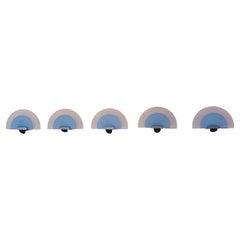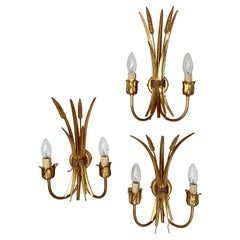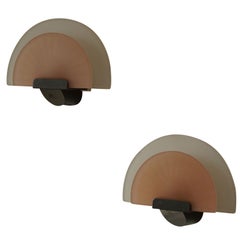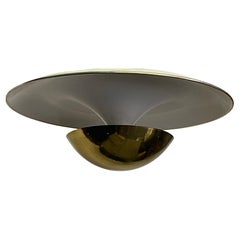Arteluce Furniture
The lighting maker Arteluce was one of the companies at the heart of the creative explosion in postwar Italian design. The firm’s founder and guiding spirit, Gino Sarfatti (1912–85), was an incessant technical and stylistic innovator who almost single-handedly reinvented the chandelier as a modernist lighting form.
Sarfatti attended the University of Genoa to study aeronautical engineering but was forced to drop out when his father’s company went out of business. His mechanical instincts led him to turn his attention to lighting design — and he founded Arteluce as a small workshop in Milan in 1939. Sarfatti’s father was a Jew, so the family fled to Switzerland in 1943, but after the war — largely thanks to Sarfatti’s insistence on efficiency of design and manufacture — Arteluce quickly established itself as a top firm.
Though Sarfatti continued as chief designer through the 1950s and ’60s, he also enlisted other designers such as Franco Albini and Massimo Vignelli to contribute work. Sarfatti sold Arteluce to FLOS — a rival Italian lighting maker — in 1973 and retired to pursue a more traditional avocation: collecting and dealing rare postage stamps.
Sarfatti is regarded by many collectors as a pioneer of minimalist design. He pared down his lighting works to their essentials, focusing on practical aspects such as flexibility of use. His most famous light, the 2097 chandelier, is a brilliant example of reductive modernist design, featuring a central cylinder from which branches numerous supporting fixtures extending like spokes on a wheel.
Similarly, Sarfatti's 566 table lamp is a simple canister, able to be raised or lowered on a stem, holding a half-chrome bulb. Despite the marked functionality of his designs, Sarfatti did have a sprightly side: His 534 table lamp, with its cluster of rounded enameled shades, resembles a vase full of flowers, the Sputnik chandelier (model 2003) was inspired by fireworks and the brightly colored plastic disks of the 2072 chandelier look like lollipops. No matter the style, Sarfatti concentrated first and foremost on the character of light created — and any Arteluce lamp is a modernist masterpiece.
Find vintage Arteluce table lamps, chandeliers, floor lamps and other lighting on 1stDibs.
Mid-20th Century Italian Art Deco Arteluce Furniture
Metal
1980s European Art Deco Vintage Arteluce Furniture
Glass
1970s German Space Age Vintage Arteluce Furniture
Chrome, Metal, Aluminum
1980s Italian Hollywood Regency Vintage Arteluce Furniture
Steel
1950s French Mid-Century Modern Vintage Arteluce Furniture
Metal
1960s Italian Mid-Century Modern Vintage Arteluce Furniture
Metal
1990s Italian Post-Modern Arteluce Furniture
Metal, Chrome
Mid-20th Century Italian Mid-Century Modern Arteluce Furniture
Brass
Late 20th Century Italian Mid-Century Modern Arteluce Furniture
Steel
Late 20th Century Italian Arteluce Furniture
Steel
1980s Italian Mid-Century Modern Vintage Arteluce Furniture
Aluminum
1980s Italian Space Age Vintage Arteluce Furniture
Metal
1960s Italian Mid-Century Modern Vintage Arteluce Furniture
Metal
1950s Italian Mid-Century Modern Vintage Arteluce Furniture
Metal, Brass
Late 20th Century Italian Art Deco Arteluce Furniture
Glass
1950s German Art Deco Vintage Arteluce Furniture
Metal, Brass
1980s Italian Art Deco Vintage Arteluce Furniture
Glass
1980s Italian Art Deco Vintage Arteluce Furniture
Metal





